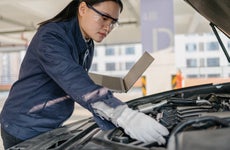How to buy a car from a private seller — and what to watch for

The Bankrate promise
At Bankrate we strive to help you make smarter financial decisions. While we adhere to strict , this post may contain references to products from our partners. Here's an explanation for .
Buying a car from a private seller can be a great way to get a good deal on your next ride. However, it requires more caution and steps than buying from an established business. You can protect yourself and your funds by carefully researching and following safety best practices.
1. Lock in vehicle financing
Whether you are purchasing from a traditional dealer or from a private party, walking in with vehicle financing you were preapproved for ahead of time is key to saving money. Apply to at least three different lenders that offer private-party auto loans. Banks such as Bank of America and online lenders like myAutoLoan offer these loans.
This way, you can compare potential rates and terms and walk into the buying process with a firm grasp of how much you can afford.
2. Search for cars
Now that you know what you can afford, it is time to look for your vehicle. You can search sites like Craigslist or Facebook Marketplace, visit dedicated car-buying apps and websites like Autolist or Cars.com or search ads in your local classifieds. Look out for specifics on each vehicle’s mileage and history. It is also wise to research the vehicle model and be sure it isn’t under an active recall.
3. Gather information on the vehicle
Once you find the vehicle, you can then reach out to the seller. Ask any remaining questions missing from the ad.
Be sure to ask for a copy of the vehicle history report, which uses the vehicle identification number (VIN) to find past owners, title history, damages, accidents and repairs. The vehicle history report will disclose the latest available mileage reading on the car, which should be close to what the odometer reads when you go for a test drive.
Wait to plan a vehicle test drive until after your questions are answered.
4. Meet the seller and check out the vehicle
Stay safe when you meet the seller. These tips may reduce your risk of encountering a dangerous situation.
- Arrange to meet in a public place, such as a busy parking lot.
- If at all possible, schedule your meeting while the sun is still up. If this isn’t possible, plan to meet in a very well-lit area.
- Bring a friend or family member with you.
- Avoid carrying large amounts of cash to your meetup. Instead, if you decide to purchase the vehicle, consider getting a money order or cashier’s check from your bank.
5. Take a test drive
Take a good look at the interior and exterior of the vehicle before you start your test drive. Be sure to test the following features during your test drive:
- Technology, electronics, Bluetooth and speaker systems.
- Headlights, high beams and signals.
- Your comfort level in the cabin: Do the seats, mirrors, headrests, cup holders, etc., adjust to your liking?
- Sight lines: Are there significant blind spots for the driver?
- Acceleration, handling, and braking at highway speeds and on city streets.
- Gagues and control panels: Are you comfortable with how speed, fuel levels and efficiency, gear display and other instruments appear? Is it easy to adjust the heating, air, windshield wipers and stereo?
6. Get the vehicle inspected
Following your experience driving the vehicle, it is wise to have it inspected by a professional. Ask the owner if the vehicle can be taken to your mechanic. You can have the mechanic look under the hood and confirm that there aren’t any hidden vehicle issues. An engine oil analysis may also be worth the effort. If the owner has any qualms with this request, it is best to walk away — they may be trying to hide a problem with the vehicle.
7. Make an offer and close the deal
Once you know the vehicle is in good condition and are sure you want to purchase it, it is time to make an offer. While you should use their posted asking price as a jumping-off point, use any vehicle issues you found in the inspection process as leverage for a better deal.
Check Kelley Blue Book to see the vehicle’s typical selling price. Remember that your greatest power in negotiating the car’s price is your ability to walk away.
8. Do your paperwork and register the car
Once you have purchased the vehicle, you must sort out the paperwork. You and the seller will need to handle transferring the car title to you. Check with your state’s Department of Motor Vehicles office to know which documents you will need.
Typically, you will want:
- The car title with seller and buyer signatures.
- Paperwork verifying the vehicle’s VIN and odometer reading.
- Smog test results, if required by your state.
- Any warranty paperwork, if this applies.
- A bill of sale specifying the legal transfer of ownership.
- A lien release, if the vehicle was financed.
Don’t forget to register the vehicle in your state once it is in your possession; you will usually have a grace period from the date of sale to do so. This can be done at a DMV office.
Risks of buying a car from a private seller
While buying a vehicle from a private seller can save you money, some private sellers are less than honest. Look out for these common car scams.
- Title washing: Title washing happens when a vehicle has a salvage title, and the seller alters the document to remove mention of the salvage. Buyers can check a vehicle’s salvage history during a VIN check.
- Guaranteed payment: Some sellers ask buyers to pay using a payment platform, like Venmo or PayPal, in exchange for a used car guarantee. In reality, these payment platforms are not involved in any used car sales, and there is never a guarantee with a private seller transaction unless otherwise specified.
- Curbstoning: Curbstoning happens when a professional dealership pretends to be a private car seller and makes changes to a vehicle to hide major problems like flood damage. Most curbstoners do not have service records, which is one way to rule them out.
- Odometer tampering: Some older used cars may allow for easier odometer tampering. Mileage that is very low for the year could be a red flag for odometer rollbacks. Sellers who have replaced the motor or transmission need to specify if the listed mileage is the actual mileage.
Online transactions like those on Facebook Marketplace can be particularly risky for buyers, so proceed cautiously.
Scams can be avoided if you look out for common red flags.
- Do not buy from a seller who seems too pushy.
- While there is emotion attached to vehicle sales, trust your instinct. Don’t overlook potential problems just to drive a particular car.
- Never purchase a vehicle sight unseen.
- If the seller asks you to pay by wire transfer, refuse. They make it difficult to recover your money if you’ve been defrauded.
The bottom line
Buying a vehicle from a private seller is a great way to save money. But it does come with additional risk, so be sure to complete an in-depth vehicle inspection and walk away at the first sight of anything suspicious.
FAQs about buying a car from a private seller
-
You do not need insurance to buy a car. However, you will need car insurance to legally drive the vehicle from the location of the sale to your home and later to the DMV. If you have an existing car insurance policy, it might cover the new car for a short period before the vehicle gets added to the policy.
-
If the seller doesn’t have the car’s title, proceed with caution and clarify the reason for the absence of the title. The seller should have the title to legally transfer ownership of the vehicle. If the title is lost or misplaced, the seller can apply for a duplicate title from the DMV. However, if the seller won’t explain or obtain a duplicate title, reconsider the process. You may be buying a stolen car.
-
To check if a car is stolen, you can verify the VIN with local law enforcement or online databases like the National Insurance Crime Bureau’s (NICB) VINCheck or the National Highway Traffic Safety Administration (NHTSA). Additionally, ensure that the VIN on the vehicle matches the one on the title and registration documents. If there are discrepancies or if the seller refuses to provide VIN information, don’t buy the car.
Related Articles



